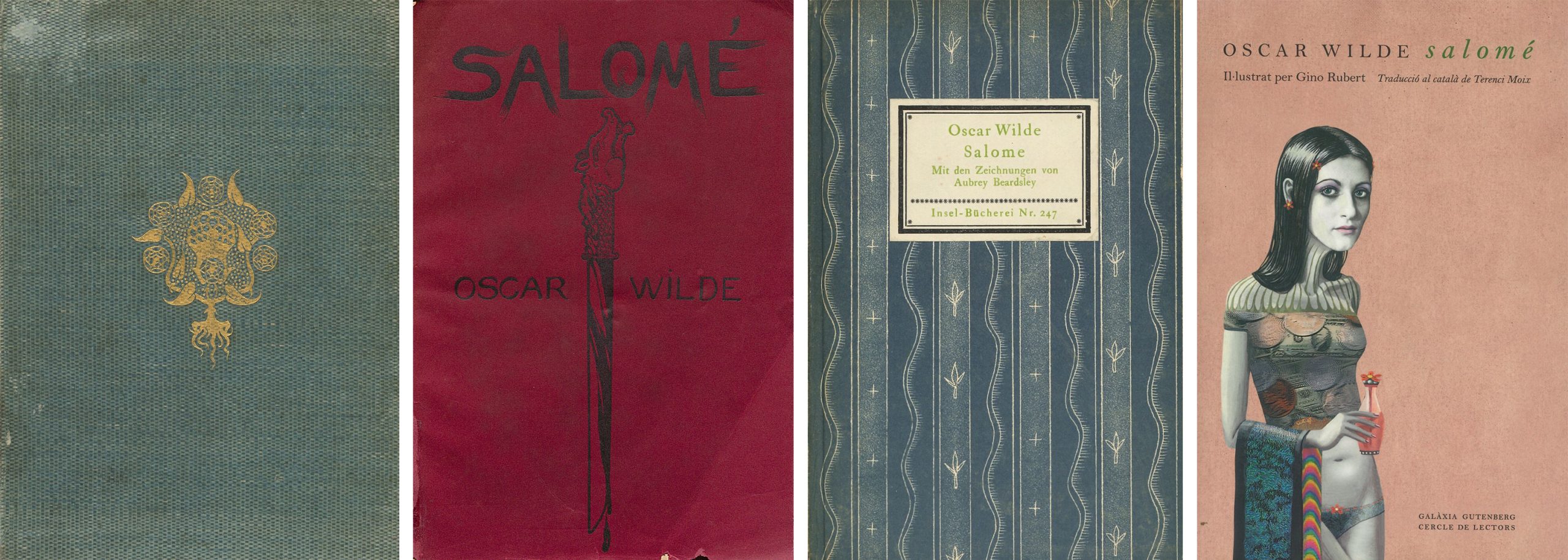Raúl Gimeno and Sandra Herrera
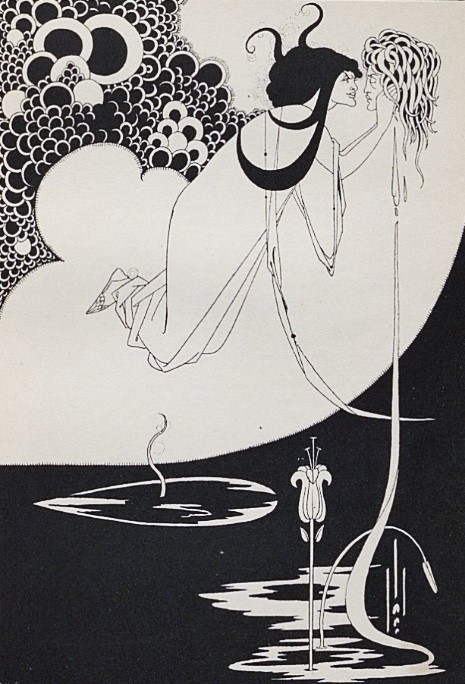
Illustration by Aubrey Beardsley in Salomé: a tragedy in one act (1894). Source: Joaquim Folch i Torres Library
Ah! I have kissed thy mouth, Iokanaan.
I have kissed thy mouth. There was a bitter taste
on thy lips
Oscar Wilde
Within the collection of the Joaquim Folch i Torres Library you can find four different editions of Salomé by the Irish writer Oscar Wilde. For this drama in one act, Oscar Wilde took as reference the execrable episode between Princess Salomé and John the Baptist (Iokanaan) in Herod’s palace. The play’s development generates a growing love-death tension that reaches its climax when Salome kisses the decapitated head of Iokanaan. Written in 1891 during Wilde’s stay in Paris, the work was not published until 1893. Salomé was originally published in French with a dedication to the poet Pierre Louÿs. From the very beginning, as we will see below, a shadow of controversy and scandal accompanied the work.
1894. Salomé: a tragedy in one act by Oscar Wilde with illustrations by Aubrey Beardsley
The oldest Salomé preserved in the Museum’s library dates from 1894. It is the first edition in English and only 500 copies were printed. The text is presented with black and white illustrations by Aubrey Beardsley, of whom Alexandre de Riquer stated in the first issue of the magazine Joventut from 15th February 1900 that he was a “very original artist, with his own character, without precedent”. Riquer pointed out in this same article that Beardsley’s illustrations had sparked very lively discussions.
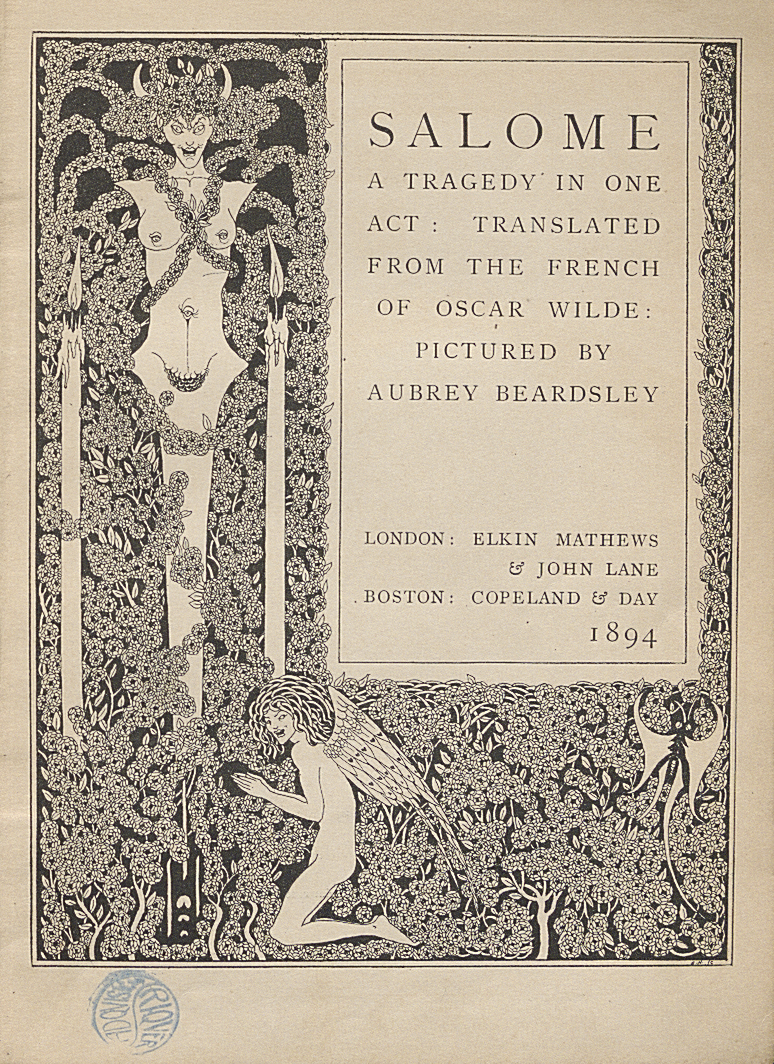
Salomé: a tragedy in one act (1894). Source: Joaquim Folch i Torres Library
This same copy from 1894 is the one that belonged to the private library of Alexandre de Riquer. When he died, his heirs sold part of his collection to the Junta de Museus, which represented the seed for the collection of the Joaquim Folch i Torres Library.
Image03
Ex-libris of A. de Riquer in the copy of Salomé (1894) / Ex-libris of A. de Riquer in issue number 1 of 1,893 of the magazine The Studio / Cover of issue Nº 1 of the magazine The Studio. Source: Joaquim Folch i Torres Library
On 1st April, 1893, a year before the first English edition saw the light of day, some illustrations by Beardsley appeared in issue number 1 of the magazine The Studio. The London publication echoed the work of the young British illustrator in the article “A New Illustrator”, in which some of his most relevant works were reproduced: Salomé, The Death of Arthur, Siegfried, etc.
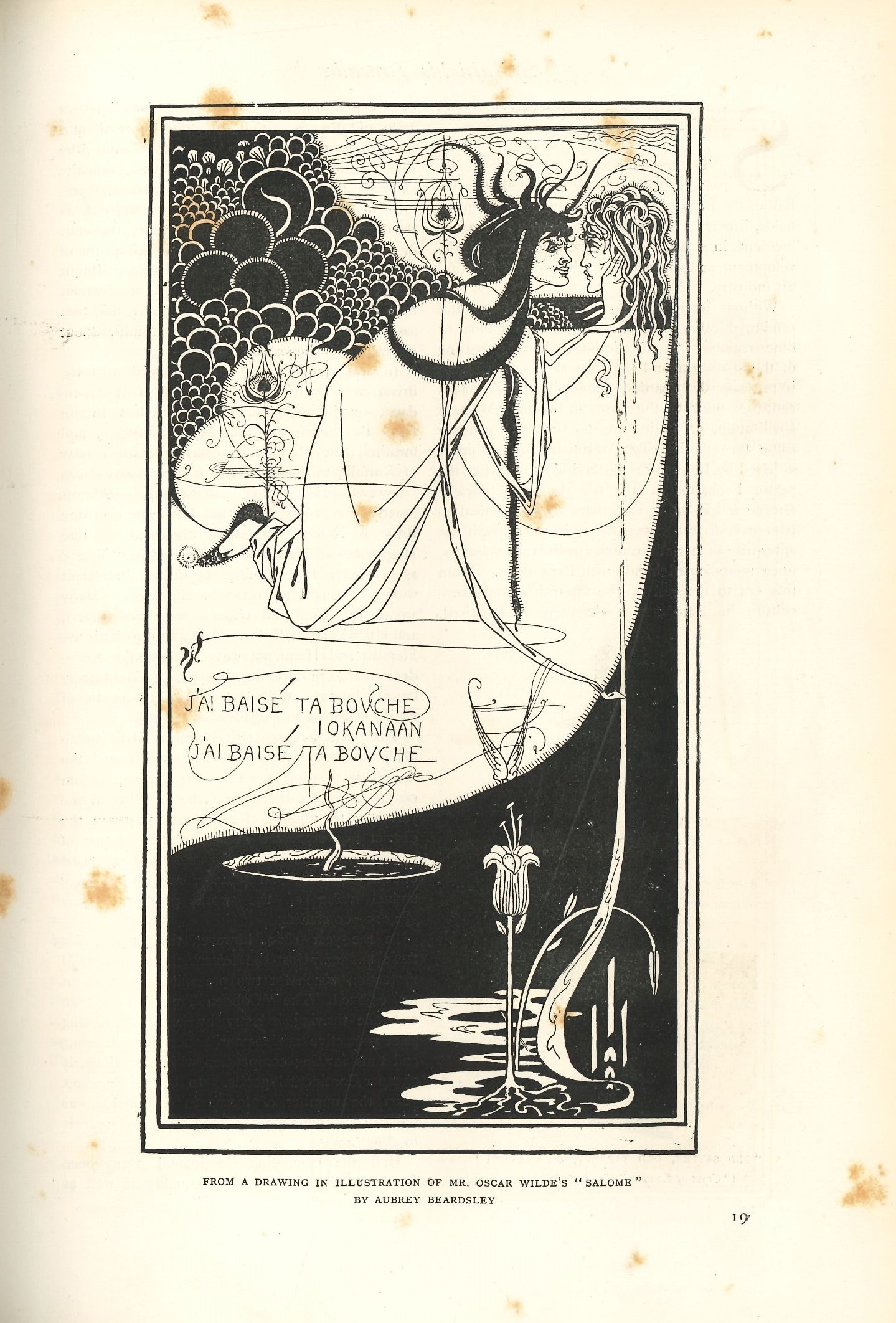
Illustration by Aubrey Beardsley for Salomé published in The Studio (1893). The 1894 English translation does not include the French text that appears in the illustration: “J’ai baisé ta bouche, Iokanaan / j’ai baisé ta bouche”. Source: Joaquim Folch i Torres Library
1908. The first translation into Catalan
Another edition of Salomé held by the Joaquim Folch i Torres Library dates from the beginning of the 20th century. We refer to the first Catalan translation, a work by Joaquim Pena and with illustrations by Adrià Gual in 1908.
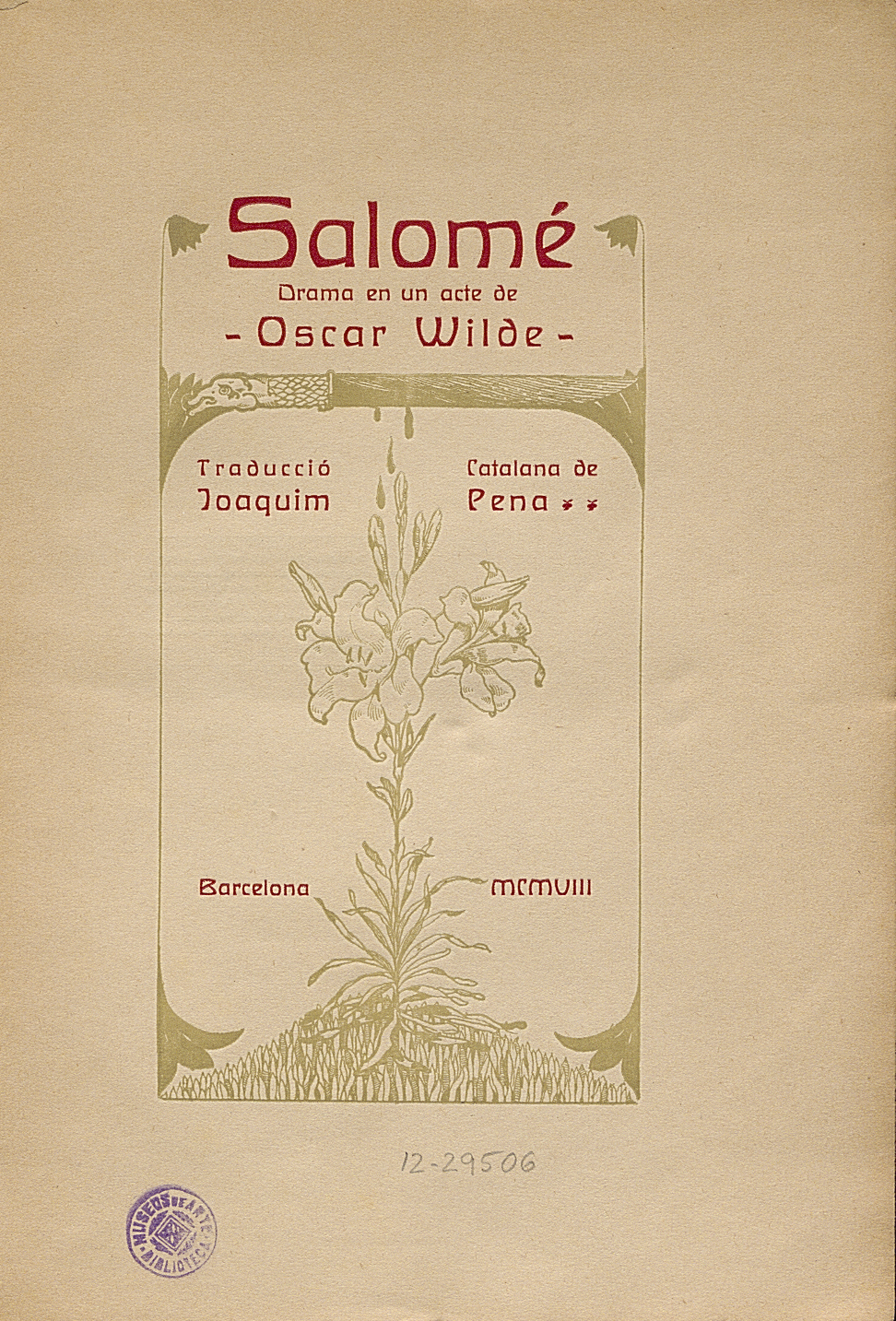
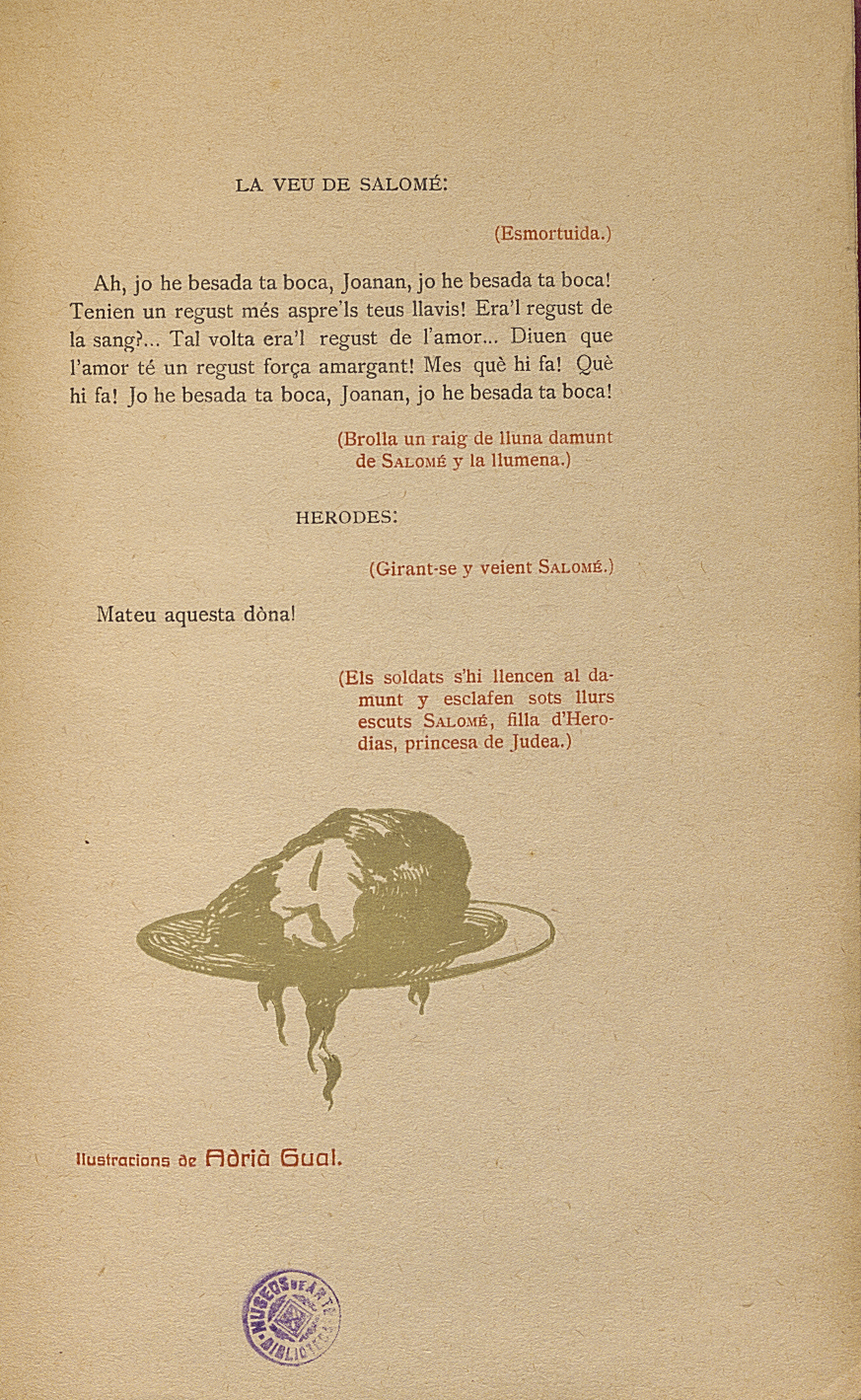
Cover of Salomé: drama in one act by Oscar Wilde (1908) / Interior illustration by Adrià Gual for Salomé: drama in one act by Oscar Wilde (1908). Source: Joaquim Folch i Torres Library
Joaquim Pena, president of the Associació Wagneriana, was a renowned interpreter who translated several dramatic works into the Catalan language, in addition to being a music critic in publications such as Joventut, El Correo Catalán and La Publicitat. The artist and playwright Adrià Gual, founder of the company Teatre Íntim, was an outstanding promoter of modernism, as well as actively participating in the renewal of Catalan theatre. His drive was decisive in disseminating the work of playwrights such as Ibsen, Hauptmann or Maeterlinck in Catalonia.
Small catalogue of the exhibition of paintings byAdrià Gual organised by the Galeries Pictoria (1941). Source: Joaquim Folch i Torres Library / Casas, Ramon, Portrait of Adrià Gual, c. 1897-1899. Museu Nacional d’Art de Catalunya
The theatrical performance and Margarita Xirgu
A peculiarity of Wilde’s Salomé, no matter which edition it is, is that the signs and indications that make it up require it to be interpreted and brought to the stage in front of the audience. His destiny is to incarnate. The play was to have its world premiere in London with Sarah Bernhardt as leading lady but Lord Chamberlain (Great Britain’s censor) opposed it and managed to avoid the representation under the protection of the law that prohibited the representation of biblical characters. So, Salomé ended up being first performed in the Théâtre de l’Œvre of Paris in 1896.
At the beginning of February 1910 in Barcelona there was a fashion that could well be called “the era of the Salomés”. The theatrical performance and the operatic adaptation of Salomé coincided in the city. This singular fact is magnificently reflected in the article that Raimon Casellas published in the artistic page of La Veu de Catalunya on 10th February 1910: “So, between the lyrical “Salomés”, sung by Bellincioni, and the dramatic “Salomés” recited by Xirgu, […] we have had a veritable constellation of heroines [sic] invented according to Oscar Wilde’s poem. “The distinguished art critic took advantage of Salomé’s exceptional presence in Barcelona’s cultural scene in those days to discuss the subject of representations of the daughter of Herod in Gothic altarpieces in Catalonia.
Wilde’s drama had reached the Teatre Principal de Barcelona on 5th February 1910 with Margarita Xirgu in the role of Salomé. On 25th February, just three weeks later, due to the strong pressures it suffered, the company had to move to Paral·lel, to the Teatre Nou.
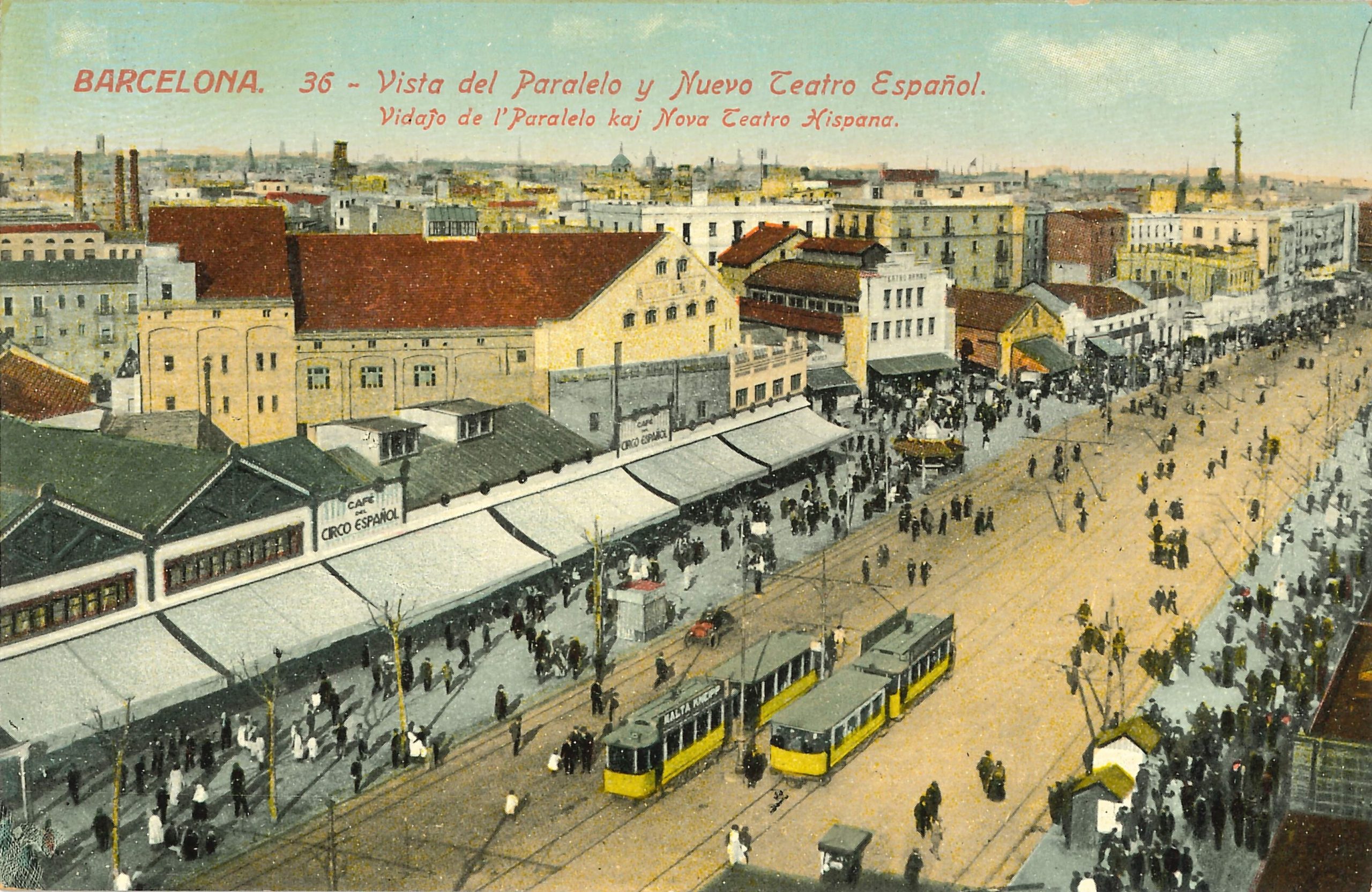
Avinguda del Paral·lel and Teatre Nou. Source of postcards from the Llegat Matas-Ramis of the Joaquim Folch i Torres Library
The interpretation of Margarita Xirgu aroused antagonistic positions among specialised critics. Among the favourable ones was Eugeni d’Ors (under the pseudonym Xènius), that would request in issue number 3,875 of 16th February 1910 of La Veu de Catalunya a “national travel grant” (that is, financial aid) so that “our noucentista actress” could travel for a couple of years in Europe to complete her training. In a completely opposite way, both in terms of tone and content, Revista Dramática was positioned under the rubric of J.B. y J. on 8th February 1910. Wilde’s dramatic poem was judged from a purely artistic point of view as, “very average”. That is to say, mediocre. And beyond the artistic side, it was considered directly “disgusting”. Joaquim Pena’s translation was considered – taking the opportunity to make a play on words – painful. And finally, regarding the role of Margarita Xirgu, it was stated that she didn’t know how to dance, “although she does it as she moves”. It did seem that there was a quorum on one point: the public mostly liked the work and the interpretation of Xirgu, who was undoubtedly a better actress than dancer.
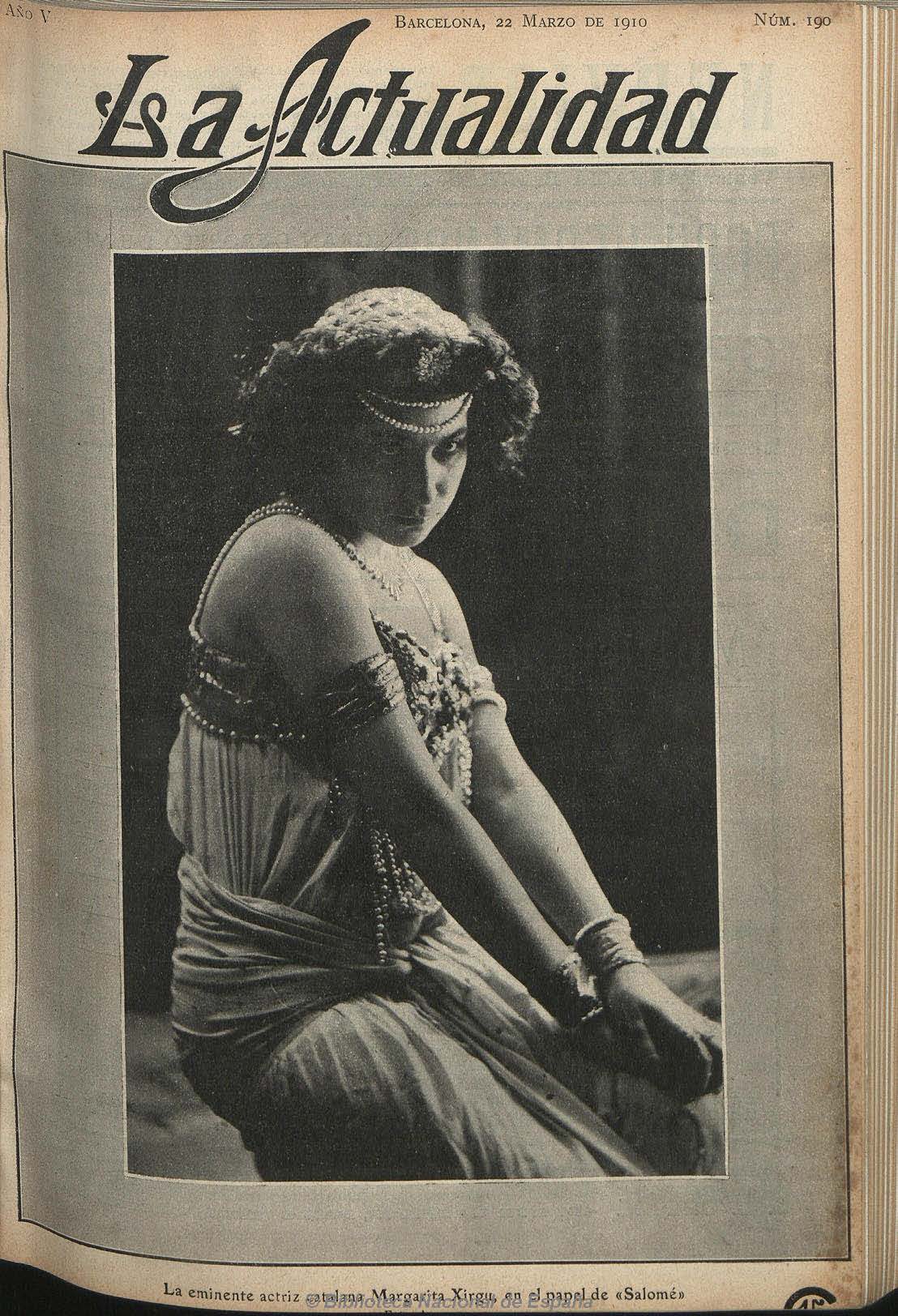
Margarita Xirgu in the role of Salomé. Cover of issue nº. 190 of 22nd March 1910 of the magazine La Actualidad
The operatic adaptation and Tortola Valencia
The opera, for its part, made its debut in the Gran Teatre del Liceu on January 29, 1910, just a few days before the theatrical version based on the translation by Joaquim Pena. The soprano Gemma Bellincioni gave life to the daughter of Herod and her interpretation seemed to have completely pleased the critics and the public.
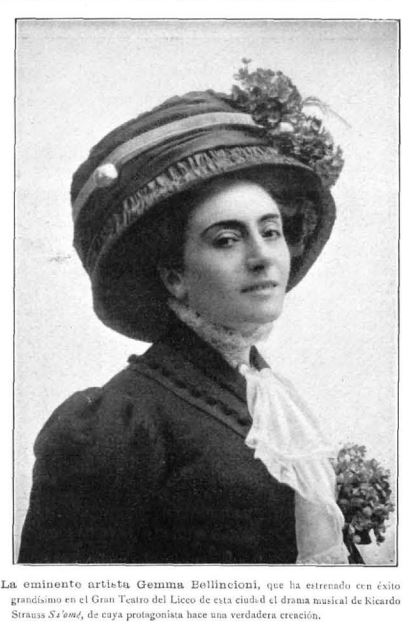
Gemma Bellincioni. Detail of issue nº. 1,467 of 7th February 1910 of La Ilustración Artística, p. 98
The operatic piece was the work of Richard Strauss based on a German translation of Wilde’s Salomé. Its premiere took place in Semperoper of Dresden on 9th December, 1905, and right from the start it sparked controversy around the world. La Vanguardia echoed the controversy generated in Wilmington, in the state of Delaware, USA. In the edition of 24th May 1907 it can be read that the American public was shocked by Strauss’s impudent opera, which motivated the intervention of the authorities in order to imprison the director and the administrator of the theatre “accused of having failed to the ordinances that prohibit the representation of any immoral work.” The lead performer and dancer of the Dance of the Seven Veils were also arrested, although all were eventually released on bail. Even when in 1949 Peter Brooks directed his version of the Strauss opera with scenography by Salvador Dalí, Salomé continued to scandalise the public and authorities.
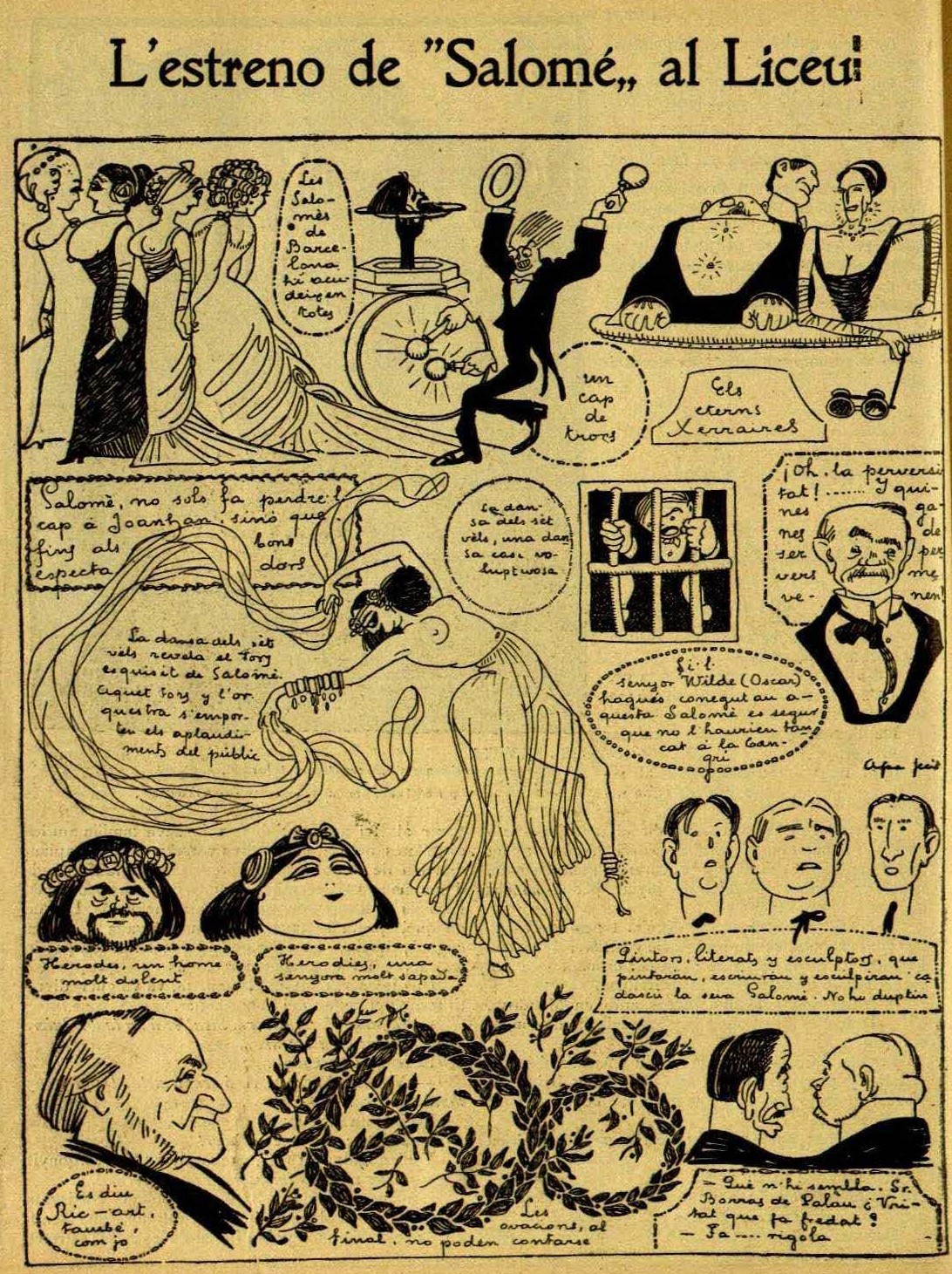
Graphic representation of APA (pseudonym of Feliu Elias) of the premiere of the opera in issue number 62 of 2nd February 1910 of the magazine Papitu
The performance moved to the Teatro Real de Madrid and the opera was premiered on 16th February, 1910, a few days after the Liceu premiere. The theatrical interpretation, however, would not arrive on the Madrid stage until two years later. The actress Lyda Borelli played the role of Salomé in the Teatro de la Comedia. On the occasion of the premiere, Emilia Pardo Bazán signed a chronicle in issue number 1,587 of 27th May 1912 of La Ilustración Artística vindicating the Wilde tragedy: “And I don’t want to miss the opportunity to insist that Salomé is one of the masterpieces that art has produced, in the recent period, between the end of the 19th and the beginning of the 20th century”.
One of the dancers whose role was to perform the dance of the seven veils with great success was Carmen Tórtola Valencia, about which Pardo Bazán said on 27th July, 1919, in the “Crónicas de España” section of the Argentine newspaper La Nación, that she was a “Byzantine icon” and that her triumph “is the costume, not nakedness”.
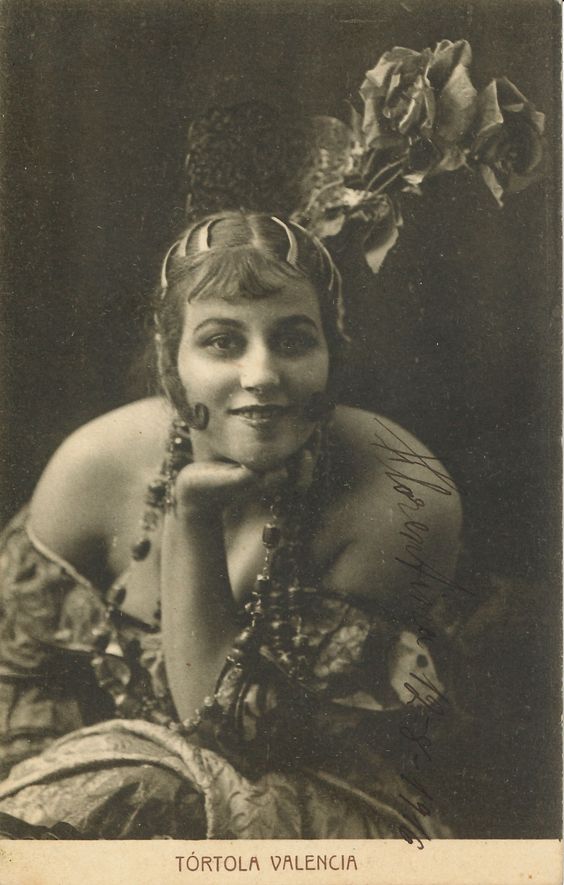
Carmen Tórtola Valencia. Source of postcards from the Llegat Matas-Ramis of the Joaquim Folch i Torres Library
In the collective imagination, Salomé dancing barefoot is associated with women as erotic desire and perdition. The sensual dance of Tórtola Valencia and the exoticism of the dancers’ clothing raised passions among the audience. It should be remembered that Tórtola Valencia was the muse of artists and writers such as Zuloaga, Julio Romero de Torres, Rafael de Penagos, Valle-Inclán, Pío Baroja, Ramón Pérez de Ayala, Jacinto Benaventeo and Emilio Carrere.
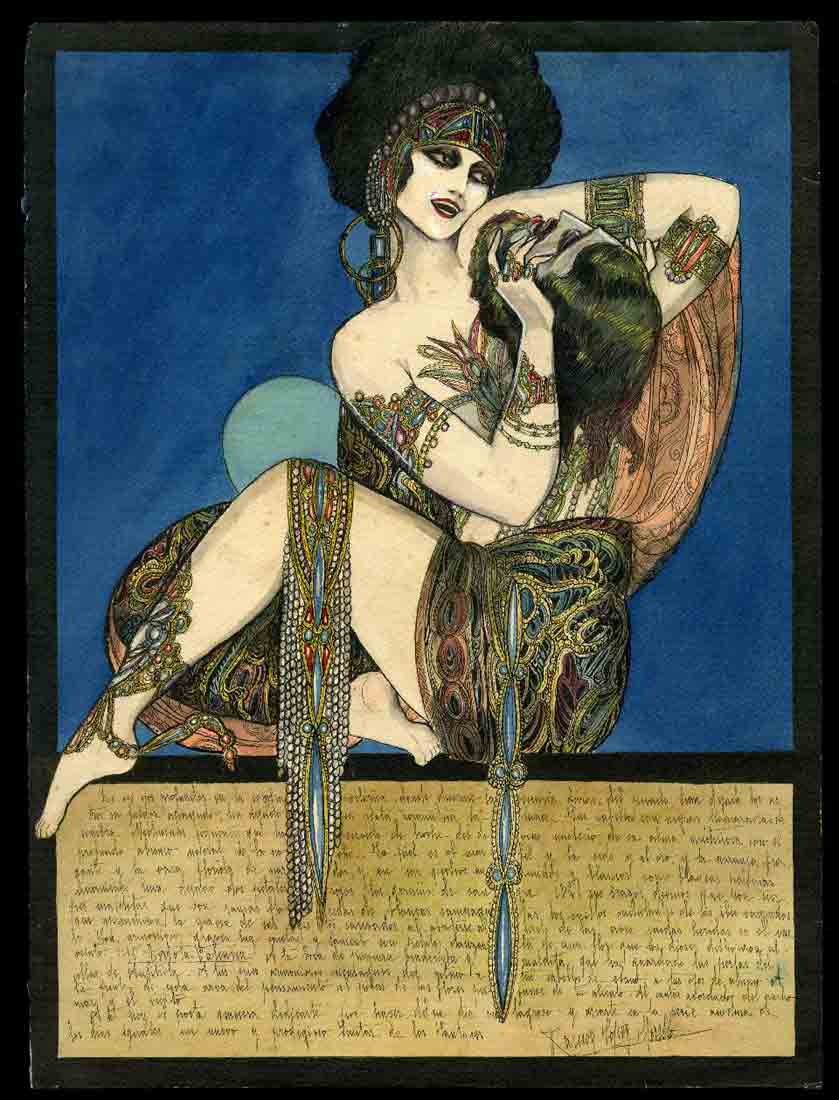
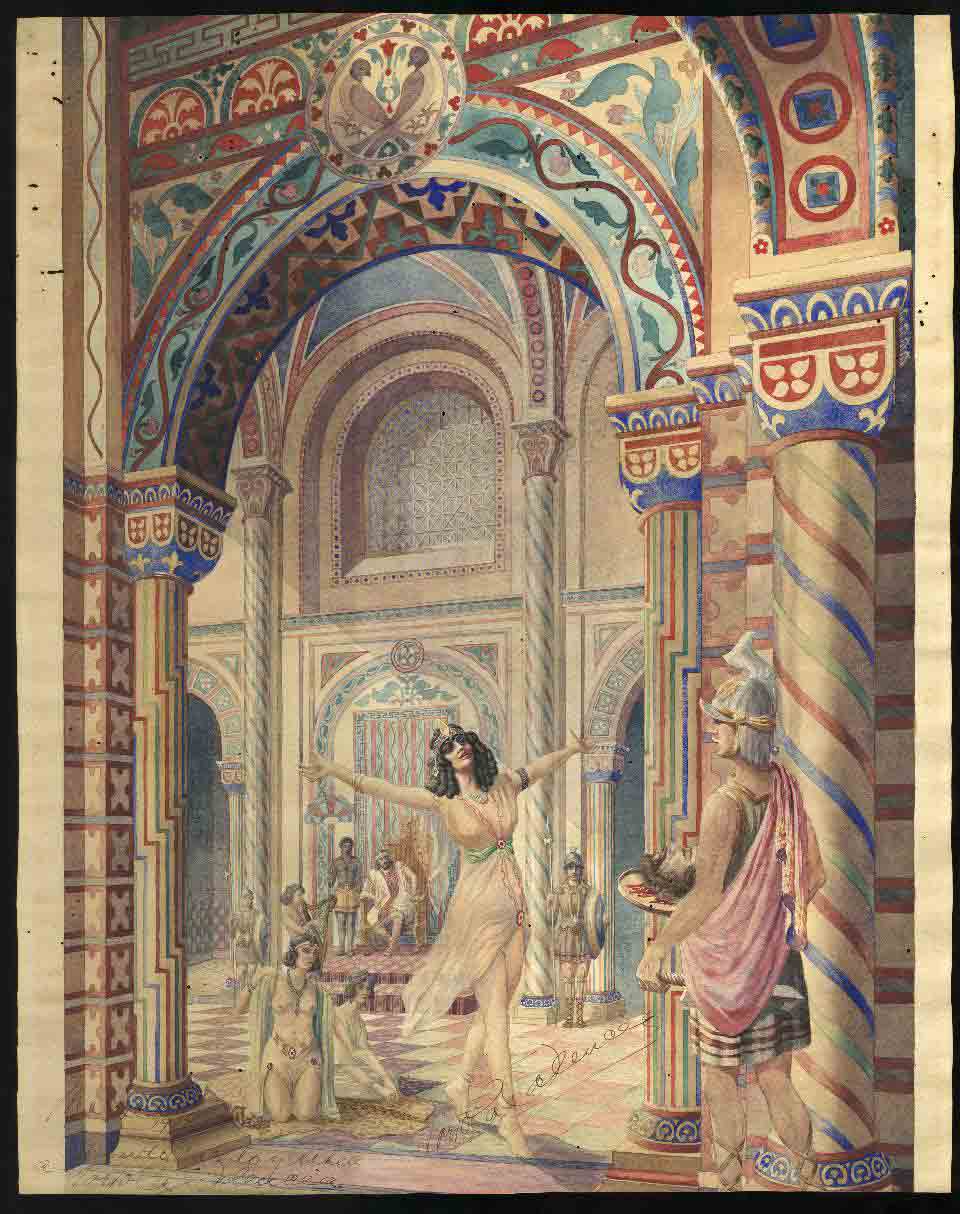
Carmen Tórtola Valencia in the role of Salomé. Drawing by Ramon Soler. Source: Institut del Teatre / Carmen Tórtola Valencia in the role of Salomé. Drawing by Ricardo Macedo. Source: Institut del Teatre
20th Century. German edition
In October 2020, the Joaquim Folch i Torres Library received the donation of 45 boxes of various documents. Among the volumes that made up the donation were several issues of the collection of Insel-Bücherei published by Insel Verlag, the publishing house created in 1901 from the literary and artistic magazine Die Insel. Issue number 247 of the aforementioned collection was dedicated to the version in German of Wilde’s Salomé, with low-quality reproductions of Beardsley’s illustrations. It is not easy to determine the date of publication because none is listed, but it was certainly printed at the beginning of the 20th century.
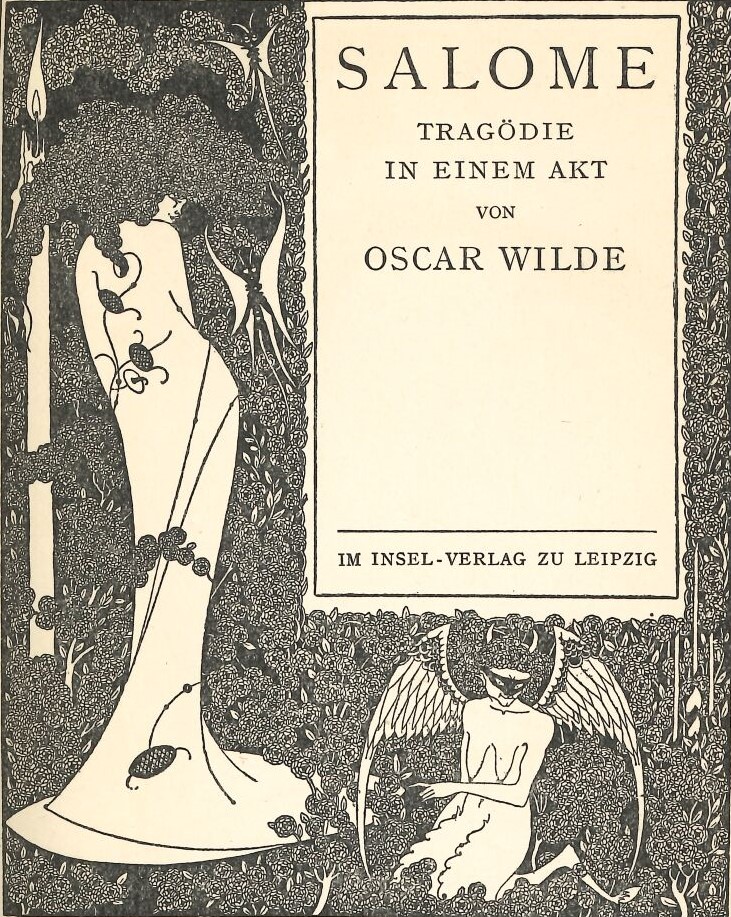
Salome:Tragödie in einem akt. Illustration by Beardsley with text in German. Source: Joaquim Folch i Torres Library
2005. Translation by Terenci Moix illustrated by Gino Rubert
The fourth copy of Salomé held by the library was published in 2005, although its entry into the collection is much more recent. It presents the Catalan language translation by Terenci Moix accompanied by illustrations by Gino Rubert. The fragment selected at the beginning of our writing is taken from this edition.
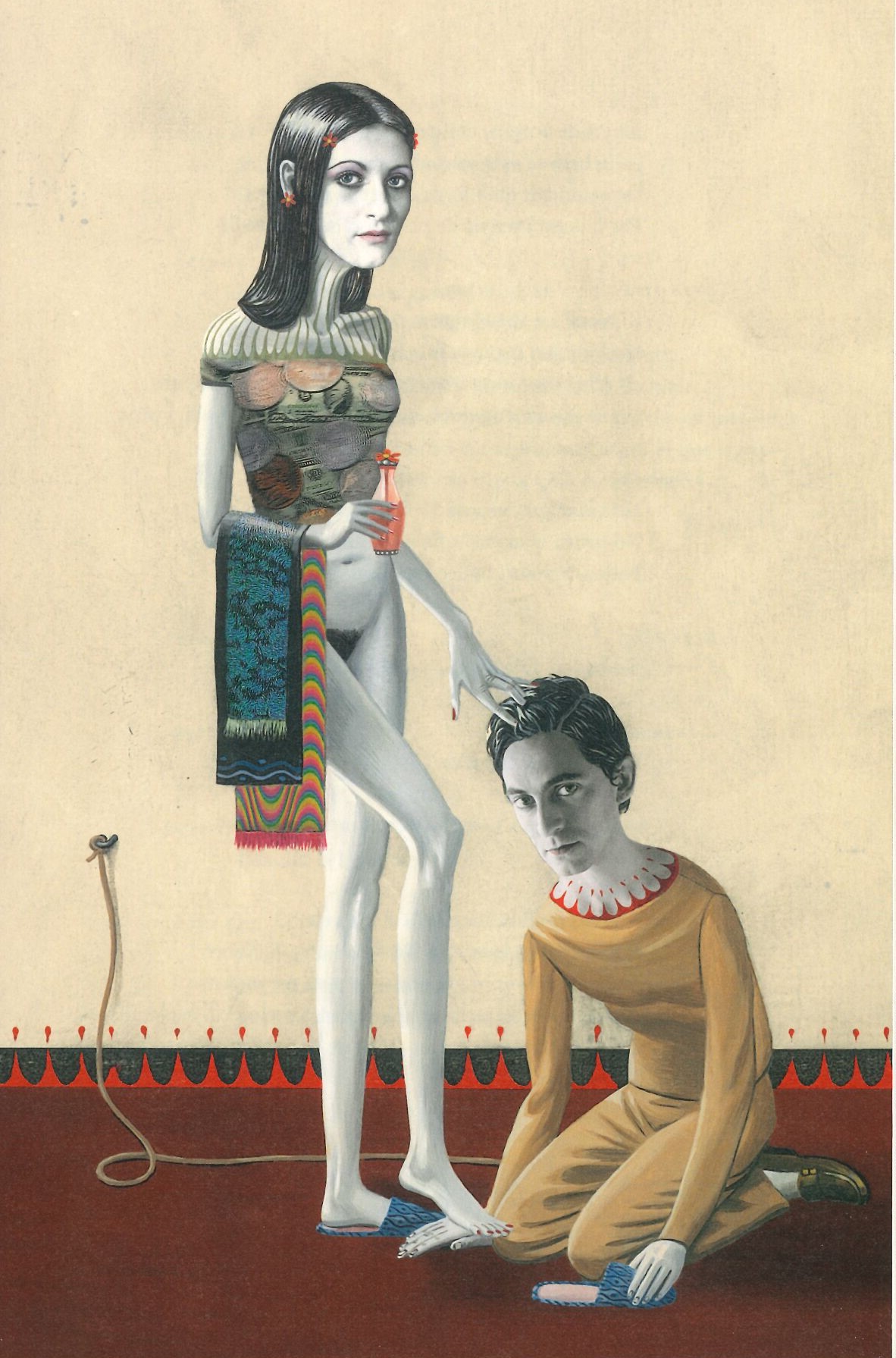
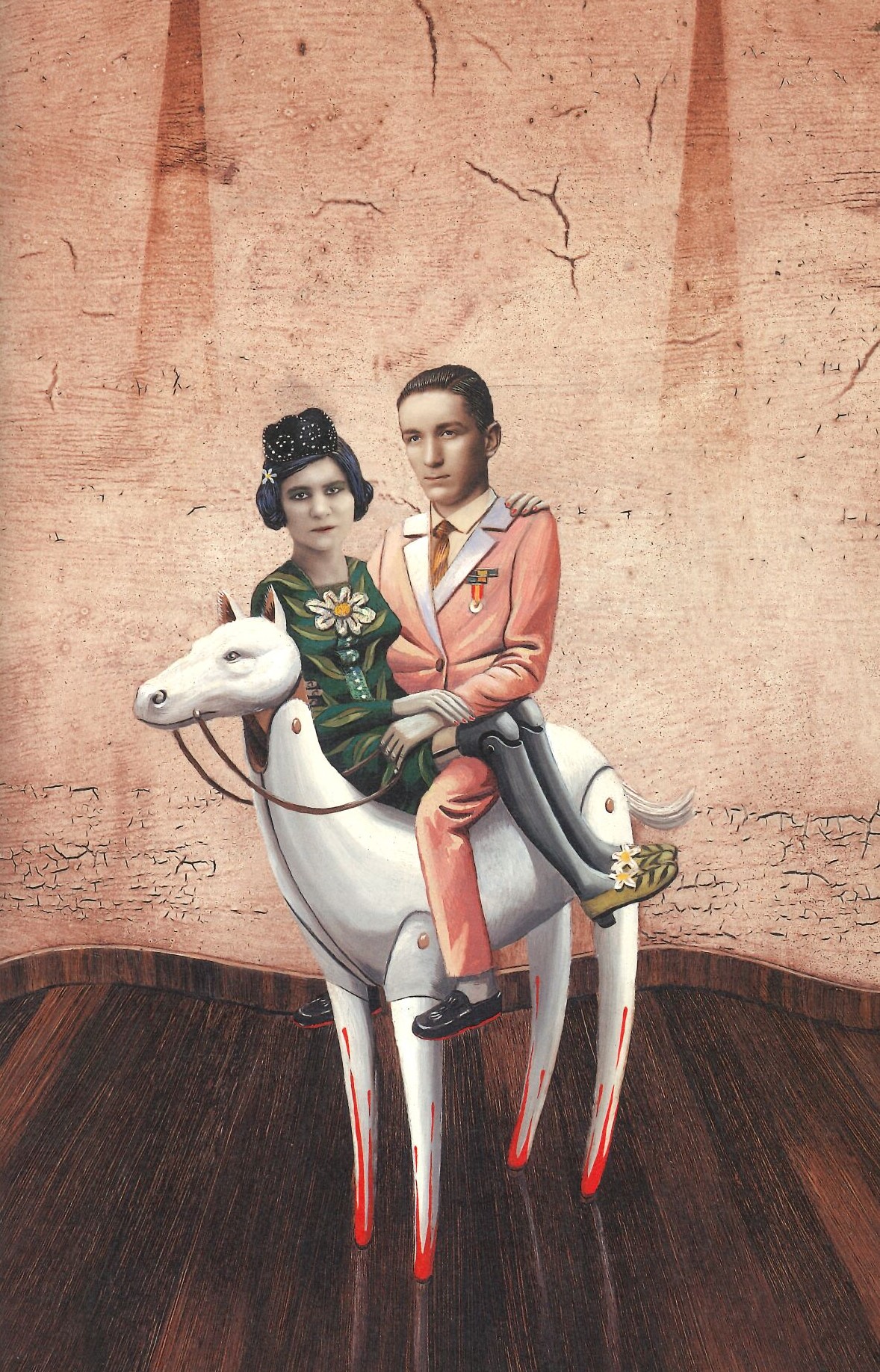
Salomé (2005). Source: Joaquim Folch i Torres Library
Editions of Salomé in the Joaquim Folch i Torres Library
As we have been able to see, the catalogue of the Joaquim Folch i Torres Library has four versions of the controversial Salomé that Oscar Wilde published in French in 1893: one in English, another in German and two in Catalan. The oldest belongs to the 19th century, two to the 20th and the most modern to the 21st century. All of them, without exception, include illustrations. Library users can consult them, in the reading room, after prior request for the documents.
Cubiertas de las cuatro ediciones que forman parte del fondo de la Biblioteca Joaquim Folch i Torres






